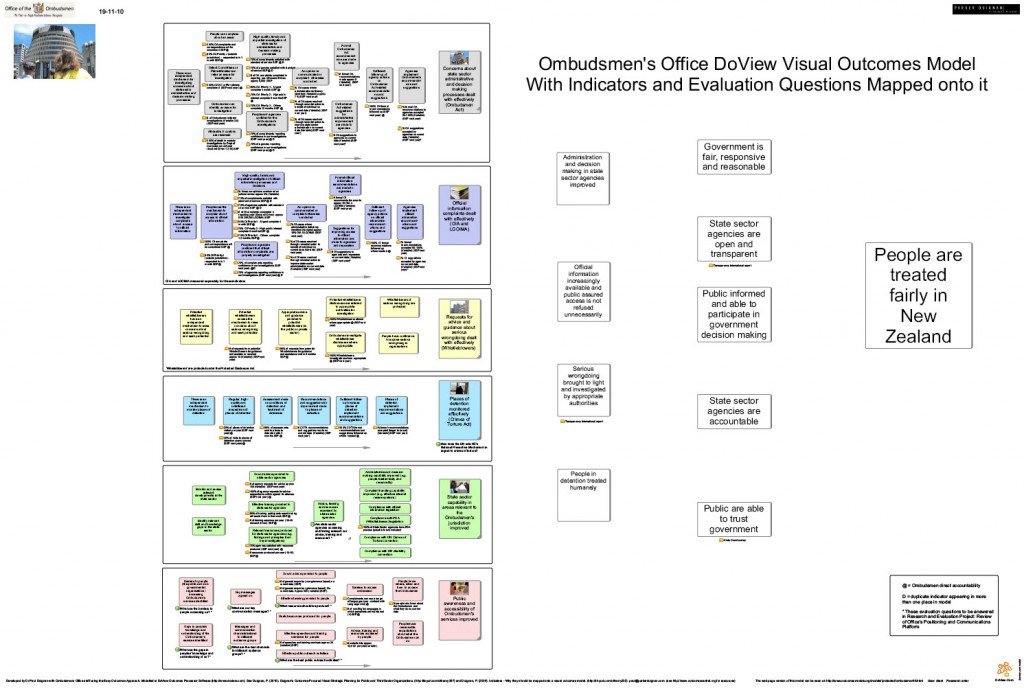AEA365 began on January 1, 2010. Before we promoted this resource, we reached out to dedicated authors who believed in the project in order to populate the site with starter content. Those who contributed in week 1 wrote for an audience of fewer than 10. One year later we have over 1500 subscribers and are re-posting the contributions from those trailblazers in order to ensure that they receive the readership they deserve! Paul was kind enough to update his original content as well.
I’m Paul Duignan, my original work has been in evaluation but more recently, like many evaluators, I’ve found myself also involved in strategic planning and related organizational activities. In the light of this experience, my recent work has focused on developing an approach which integrates evaluation with strategic planning, monitoring and other organizational activities. It is called the Duignan Outcomes-Focused Visual Strategic Planning, Monitoring and Evaluation approach. The approach is a practical approach which is based on extensive theoretical work examining new ways of thinking about monitoring, evaluation and outcomes (http://www.outcomestheory.org). The approach integrates a set of key organizational functions which in the past have sometimes been seen as separate. It does this around the use of a ‘visual outcomes model’ – think of it as being like a logic model on steroids! These models can end up being very large and need dedicated software if you are going be able to easily build and use them in realtime in meetings, for instance DoView outcomes software which I’ve been involved in developing (http://www.doview.com). Below is a poster version of an example of such a model including: steps and outcomes, indicators and evaluation questions. You may want to click back to http://aea365.org/blog/ and click on the picture to view it in a larger size.
The efficiency of this approach is that once you have the basic model you can then use it for a wide range of different organizational purposes.
Rad Resource: An article and other resources are available on how to develop a ‘DoView visual monitoring and evaluation plan’. These can be built in one third of the time it takes to write a traditional narrative text-based monitoring and evaluation plan. They are much more accessible than narrative text-based plans because you can immediately ‘see’ the evaluation questions which are being asked and where they sit in relation to the outcomes which the program is seeking. http://knol.google.com/k/paul-duignan/-/2m7zd68aaz774/134 or http://tinyurl.com/otheory267. In a recent first, a DoView visual evaluation plan, rather than a traditional text-based plan, was used to obtain funding from the Rockefeller Foundation for the global Health Information for All 2015 project. (See http://knol.google.com/k/paul-duignan-phd/evaluation-of-healthcare-information/2m7zd68aaz774/171).
Rad Resource: A second article is available on how to use the approach, not only for developing a visual monitoring and evaluation plan, but also how to use it for a whole range of other organizational activities. For instance, outcomes-focused visual strategic planning, priority setting, evidence-based practice and outcomes-focused contracting. Using a common visual outcomes model for this range of organizational activity is a really efficient way of ensuring tight organizational alignment around outcomes. http://knol.google.com/k/paul-duignan-phd/duignan-s-outcomes-focused-visual/2m7zd68aaz774/162 or http://tinyurl.com/otheory287
We are currently using the approach in a range of different organizations. If you want to follow my work look at my blog http://OutcomesBlog.org, Twitter http://Twitter.com/PaulDuignan or my E-Newsletter http://easyoutcomes.org/newsletter1.html.
Do you have questions, concerns, kudos, or content to extend this aea365 contribution? Please add them in the comments section for this post on the aea365 webpage so that we may enrich our community of practice. Would you like to submit an aea365 Tip? Please send a note of interest to aea365@eval.org.

